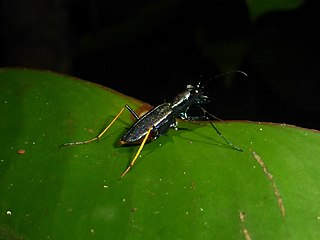
Sir Aaron Klug was a British biophysicist and chemist. He was a winner of the 1982 Nobel Prize in Chemistry for his development of crystallographic electron microscopy and his structural elucidation of biologically important nucleic acid-protein complexes.

Pentacomia is a genus in the beetle family Cicindelidae. There are more than 50 described species in Pentacomia, found in Central and South America.

The Mexican howler is a subspecies of the mantled howler, A. palliata. This subspecies is found predominantly in forests between south eastern Mexico and north eastern Peru. Typical of its species, the Mexican howler monkey has a prehensile tail, a deep jaw, and a large pharynx which it uses to make characteristically deep and resonating howls. Mantled howler monkeys are known for forming unusually large cohorts averaging 14 members and sometimes extending to 40 members.

Hiperantha is a genus of beetles in the family Buprestidae, tribe Stigmoderini, containing the following species:

Omphra is a genus in the beetle family Carabidae. There are about seven described species in Omphra.

Odontocheila is a genus in the beetle family Cicindelidae. There are more than 70 described species in Odontocheila, found in South America, Central America, and Mexico.

Mylabris is a genus of beetles in the family Meloidae. It is endemic to the Palearctic realm. The species-rich genus Hycleus was historically confused with Mylabris and have their greatest diversity in the Afrotropics.
Acyphoderes is a genus of beetles in the family Cerambycidae, containing the following species:
Epimelitta is a genus of beetles in the family Cerambycidae, containing the following species:
Odontocera is a genus of beetles in the family Cerambycidae, containing the following species:
Ctenodes is a genus of beetles in the family Cerambycidae, containing the following species:

Epicauta is a genus of beetles in the blister beetle family, Meloidae. The genus was first scientifically described in 1834 by Pierre François Marie Auguste Dejean. Epicauta is distributed nearly worldwide, with species native to all continents except Australia and Antarctica. Surveys have found the genus to be particularly diverse in northern Arizona in the United States. Few species occur in the Arctic, with none farther north than the southern Northwest Territory of Canada.

Hemilophini is a tribe of longhorn beetles of the subfamily Lamiinae.
Compsosoma is a genus of longhorn beetles of the subfamily Lamiinae.
Lycidola is a genus of longhorn beetles of the subfamily Lamiinae, containing the following species:

Menesia is a genus of longhorn beetles of the subfamily Lamiinae, containing the following species:
Apeba togata is a species of beetle in the family Cerambycidae. It was described by Johann Christoph Friedrich Klug in 1825. It is known from Brazil.
Icimauna ciliaris is a species of beetle in the family Cerambycidae. It was described by Johann Christoph Friedrich Klug in 1825. It is known from Argentina, Brazil and Paraguay.
Lycaneptia amicta is a species of beetle in the family Cerambycidae. It was described by Johann Christoph Friedrich Klug in 1825. It is known from Brazil.
Lycomimus ampliatus is a species of beetle in the family Cerambycidae. It was described by Johann Christoph Friedrich Klug in 1825. It is known from Brazil.









